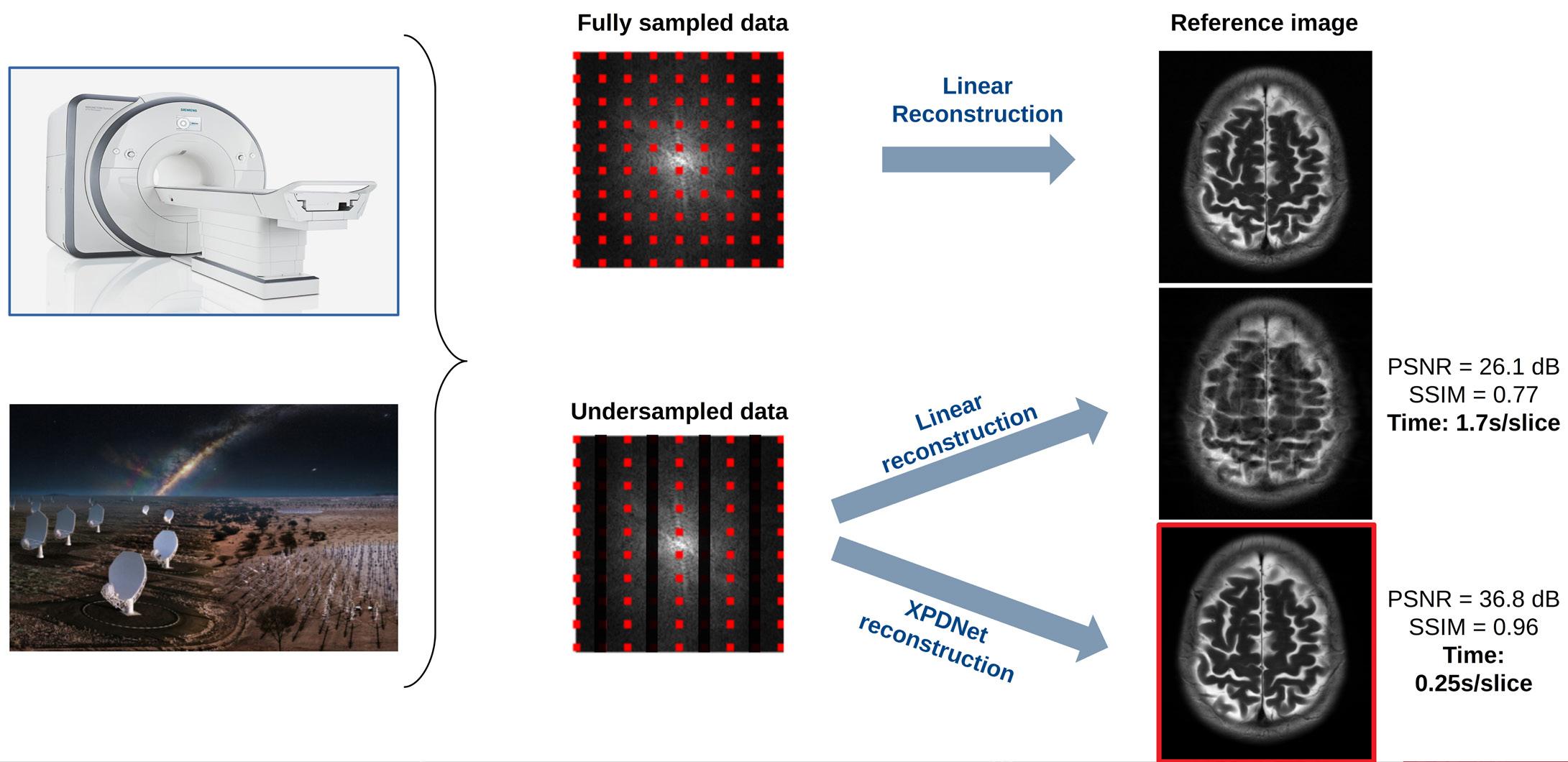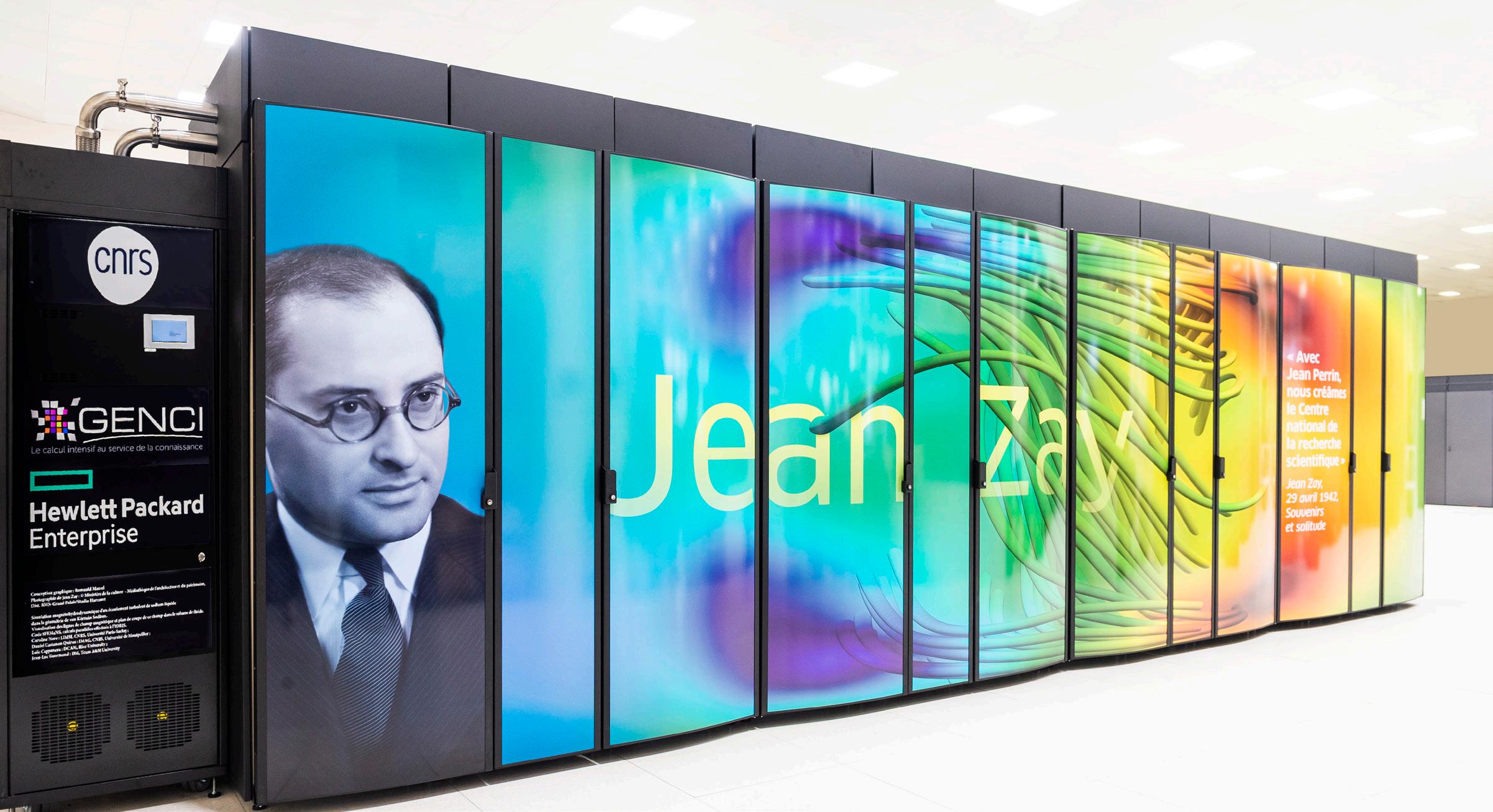
4 minute read
When the brain meets the stars: Knowledge made visible to the naked eye
from Contact 07
The data acquisition mechanisms in radio-astronomy and in magnetic resonance imaging (MRI) present similarities. In either case, the acquisition system produces data in a mathematical space, called the Fourier space, and the transition from incomplete measurements to good quality images is far from obvious (see middle figure in the image below). Experts in radio interferometry and MRI have teamed up to improve image quality in both scientific fields. They both have a common goal: getting the cleanest image possible in the fastest observation time.
When teams at the CEA in France (Commissariat à l’énergie atomique et aux énergies alternatives) joined their efforts in the COSMIC project (Compressed Sensing for Magnetic resonance Imaging and Cosmology) they showed what scientific teamwork could do by winning second place in the Brain FastMRI Challenge. This international competition was held in October 2020 and co-sponsored by Facebook AI Research and NYU Langone Health. The goal was to see how accurately an image could be made to resemble the original from information that was incomplete. Results showed that the CEA’s method provided an excellent means to reconstruct an image to be almost the same as what could be found in an original image, even with data that was far from being optimal (degraded and unclear). (See right figures in the image below.)
To do this, these two teams (one working on the brain and the other on astrophysics) used Compressed Sensing (CS), a mathematical theory invented in 2006 by two different groups in California (CalTech and Stanford).

Above: An overview of the acquisition and reconstruction process for both brain imaging and radio-astronomy. MRI and radio-telescope collecting data (left) and sampling in a mathematical space called Fourier domain (centre). In practice, we cannot have a full sampling of this space and we need to reconstruct images from subsampled data. Right, example of such reconstructions from retrospectively subsampled data with two different methods: a linear inversion method called GRAPPA that is implemented in actual MRI scanners (middle right) and the deep learning (bottom right). The original image is shown top right.
Credit: Philippe Ciuciu, CEA; SKAO, ICRAR, SARAO.
This theory revolutionised the numerical sciences and allowed the perfect reconstruction of images from a small number of measurements as long as certain mathematical properties were met. In practice, these conditions are satisfied on natural images and make the reconstruction of useful images from faraway galaxies to tiny brain structures realistic. The resulting resolution of images is actually outstanding.
Now both radio-astronomy and brain imagery can provide information about what these structures are and calculate their causes and effects. This is called ‘inverse problem solving’, and is the expertise of astrophysicist Dr Jean-Luc Starck, who heads up the Cosmostat team. The NeuroSpin team, headed by neuroimaging scientist Dr Philippe Ciuciu, brought its deep knowledge in accelerated MRI acquisition and software engineering to solve issues inherent to both domains, that is: missing data and noise or artefacts giving severely degraded images. In order to solve these image reconstruction tasks in the CS setting, the teams initially developed a multidisciplinary open source software called PySAP.
Currently, the most innovative way to solve the image reconstruction problem relies on artificial intelligence (AI). Deep learning and its neural networks (a set of algorithms which recognise patterns in data) with many layers of processing units (also called convolutional neural networks or CNNs) are able to learn what is corrupted about an image and to correct for missing data and the presence of artefacts.

The Jean Zay supercomputer, acquired by GENCI (Grand Equipement National de Calcul Intensif) and inaugurated in January 2020, is operated within the CNRS center IDRIS (Institut du Développement et des Ressources en Informatique Scientifique). In the SKA context, today Jean Zay is one of the computing facilities made available to the community to run the second SKA Data Challenge.
Credits: Cyril FRESILLON / IDRIS / CNRS Photothèque.
Their benefit is twofold: first, neural networks make it possible to recover images of a quality similar to those obtained from complete data sets by collecting even less data than in the CS framework. Second, these algorithms reconstruct the images much faster than previous nonlinear CS methods (10 to 100 times faster). Making use of this framework, the teams have proposed a very efficient hybrid CNN architecture (XPDnet) that integrates both physics-based knowledge of MRI and key aspects of optimisation into the correction process.
This new method, implemented by Zaccharie Ramzi, was the one applied to the Brain FastMRI Challenge competition. It aimed at comparing the performance in image reconstruction of different deep learning architectures from under-sampled data corresponding to faster scans. The challenge with test data is of course that no ground truth (or complete data) is available, making the competition blind and thus more difficult, yet fair to all contenders. Results showed that the CEA’s method provided clear MR images even in a degraded acquisition set-up (see right figures in the image on page 25). Results of the competition were announced last December at the NeurIPS international conference, a top-level conference in machine learning. These two teams placed second in the two supervised categories out of 19 competitors. Results will be published in 2021 in the journal IEEE Transactions on Medical Imaging.
Based on observations of the LOFAR telescope (one of the SKA pathfinders) published in Astronomy & Astrophysics in 2015, the COSMIC team has already shown that the resolution of radio-interferometry images can be improved by a factor of four (two in each direction). The team is now investigating from a SKA perspective how well these latest MRI machine learning developments impact the quality of reconstructed radio-interferometry images.
By Dr Philippe Ciuciu (CEA, Neurospin)










